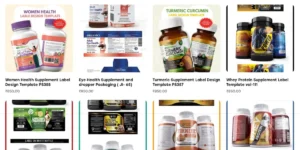Packaging is more than just a protective covering for a product—it plays a major role in influencing consumer behavior. Studies show that 70% of consumers form their buying decisions based on packaging, making it a critical marketing tool for brands.
In this in-depth analysis, we’ll explore the psychological, visual, and functional impact of packaging on customer decisions, backed by research and case studies.
1. First Impressions Matter: The Power of Visual Appeal
📊 Research Findings
- A study by Ipsos found that 72% of consumers say packaging design influences their purchasing decisions.
- 90% of shoppers make snap judgments about products within 5 seconds based on packaging.
- Color psychology research suggests that 85% of consumers buy a product due to its color.
🔹 Key Factors That Influence First Impressions
✅ Color Psychology – Bright and warm colors like red & yellow trigger excitement, while blue & green evoke trust.
✅ Minimalist vs. Bold Designs – Minimalist packaging (Apple, Tesla) attracts premium buyers, while bold, colorful packaging (Lays, Pepsi) appeals to mass consumers.
✅ Typography & Fonts – Elegant fonts suggest luxury, while playful fonts attract younger audiences.
👉 Example: Coca-Cola’s iconic red packaging creates a sense of energy and excitement, reinforcing its global appeal.
2. Emotional Connection & Brand Recognition
📊 Research Findings
- A study published in the Journal of Consumer Psychology found that emotional response to packaging increases brand loyalty by 30%.
- Consumers are 50% more likely to repurchase from brands with familiar and attractive packaging.
🔹 How Packaging Builds Emotional Connection
✅ Nostalgic Packaging – Limited edition packaging (Pepsi Retro, McDonald’s 90s packaging) brings back fond memories, increasing sales.
✅ Personalization – Brands like Nutella & Coca-Cola (Share a Coke) saw a 23% sales increase due to personalized packaging.
✅ Storytelling Elements – Brands using packaging to share their mission, origin, or sustainability efforts build deeper emotional ties.
👉 Example: Starbucks’ holiday cups create an emotional festive connection, increasing seasonal sales.
3. Functional Packaging: Convenience & Usability Matter
📊 Research Findings
- A 2019 Nielsen study found that 64% of consumers are willing to pay more for convenient & resealable packaging.
- 67% of consumers say easy-to-open packaging improves their overall shopping experience.
🔹 Functional Features That Boost Sales
✅ Easy-to-Carry Designs – Handles, grips, and compact shapes make products more convenient.
✅ Eco-Friendly Materials – 81% of consumers prefer biodegradable or recyclable packaging.
✅ Smart Packaging – QR codes, NFC tags, and AR features increase engagement and brand loyalty.
👉 Example: Heinz changed its ketchup bottle from glass to easy-squeeze plastic, increasing sales by 13%.
4. The Role of Sustainability in Buying Decisions
📊 Research Findings
- 73% of Gen Z and Millennials prefer brands with sustainable packaging (Deloitte, 2022).
- 57% of consumers are willing to pay more for eco-friendly packaging (McKinsey Report, 2023).
🔹 Key Sustainable Packaging Trends
✅ Biodegradable & Compostable Packaging – Brands like Lush & Patagonia use zero-waste packaging.
✅ Minimalist & Recyclable Designs – Apple removed chargers from its iPhone boxes to reduce waste.
✅ Refillable Packaging – Brands like The Body Shop & Dove offer refill stations to reduce plastic waste.
👉 Example: Unilever’s plastic reduction campaign boosted its eco-conscious brand image and customer loyalty.
5. Packaging & Price Perception: How Premium Packaging Increases Sales
📊 Research Findings
- 40% of consumers associate premium packaging with better quality.
- A Harvard Business Review study found that luxury brands using gold, matte black, and textured packaging saw a 25% increase in sales.
🔹 How Packaging Influences Price Perception
✅ Luxury Packaging (High-End Finishes) – Glossy, matte, metallic, and embossed textures create a premium feel.
✅ Minimalist vs. Budget-Friendly Designs – Matte black & gold = luxury, while bright colors & plastic = affordability.
✅ Unboxing Experience Matters – Apple’s slow-opening box design increases the perceived value of its products.
👉 Example: Tiffany & Co.’s iconic blue box makes their jewelry feel more luxurious and gift-worthy, justifying premium pricing.
6. Cultural Differences in Packaging Preferences
📊 Research Findings
- Asian consumers prefer bright, detailed packaging, while Western consumers prefer minimalist designs.
- In India & China, vivid colors and religious symbols play a role in buying decisions.
- Japanese packaging often emphasizes precision & presentation, influencing global luxury markets.
👉 Example: Kit-Kat’s limited-edition flavors in Japan (matcha, sake, wasabi) attract tourists and increase sales.
Final Thoughts: Why Packaging Drives Sales
| Factor | Impact on Buying Decisions |
| Visual Appeal (Color, Design, Fonts) | 72% of consumers base decisions on packaging design |
| Emotional Connection & Brand Recognition | Increases brand loyalty by 30% |
| Functionality & Convenience | 64% of buyers prefer resealable, easy-to-use packaging |
| Sustainability | 73% of younger consumers prefer eco-friendly options |
| Price Perception & Luxury Feel | 40% of consumers associate premium packaging with quality |
📌 Key Takeaways:
✔ Invest in unique, attractive packaging – Colors, typography, and textures influence customer perception.
✔ Focus on sustainability – Eco-conscious brands attract loyal customers.
✔ Make packaging functional & engaging – Easy-open, resealable, and interactive designs improve user experience.








2 Responses
The Packaging Seller’s blog explains how packaging influences consumer buying decisions, with design playing a crucial role in brand perception. Factors like color psychology, convenience, and sustainability significantly impact purchasing choices. Understanding these elements can help businesses create packaging that attracts customers and boosts sales.